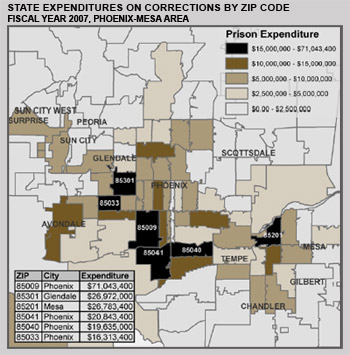 As US States face a staggering and ever increasing $50 billion for incarceration, Governors are frantically looking for alternatives. Advocates argue for making investments in programs proven to reduce recidivism. In Texas for instance, $200 million was redirected to strengthening supervision of offenders in the community and so avoided $443 million in expanding prison costs.
As US States face a staggering and ever increasing $50 billion for incarceration, Governors are frantically looking for alternatives. Advocates argue for making investments in programs proven to reduce recidivism. In Texas for instance, $200 million was redirected to strengthening supervision of offenders in the community and so avoided $443 million in expanding prison costs.
There is no doubt that investments in what works to reduce recidivism will avoid some harm to victims and postpone increases in costs of policing and prisons. There are many authorities for these claims, including the Washington State Institute for Public Policy, as well as the Criminal Justice Schools at the University of Cincinnati and at the University of Maryland provide ample evidence and direction.
Nevertheless the best reinvestments are those that stop crime and violence before offenders harm victims. Stopping victimization also eliminates the need to pay for arrests, convictions and incarceration for the victimizer. The Rand Corporation is just one of the think tanks that has analysed the research to show that parent training programs such as the proven triple P and the programs that outreach to youth at risk such as Quantum are far more cost effective than investments in probation or parole.
Despite reductions in crime and violence in the US in the last two decades, the estimates of the harm to victims of crime still exceeds $450 billion a year of which murder, drunk driving deaths and rape are major contributors.
The strategies that have reduced the injuries and deaths from street gangs in Boston, Chicago and so on provide one area for promising investment. Urban Networks To Increase Thriving Youth (UNITY) has important data to show reductions in juvenile arrests that indicate success in stopping violence.
Accelerating the programs known to reduce drunk driving deaths provides another. MADD has brought this evidence together.
Focussing in schools, colleges and universities on programs proven to reduce forcible rapes provide another area for hope. Programs such as the University of Kentucky´s Green Dot or the Canadian 4th R are examples.
Ultimately, the most cost effective solutions to reducing violence in high crime neighbourhoods must mobilise schools, housing, social services, law enforcement and others to jointly diagnose the problems that cause excessive violence and jointly implement effective preventive and not just re-entry solutions. The evidence today from the World Health Organization and many other authorities is that when it comes to reducing harm to victims of crime an ounce of prevention is worth a pound of cure.
(Photo credit: The Council of State Governments)

